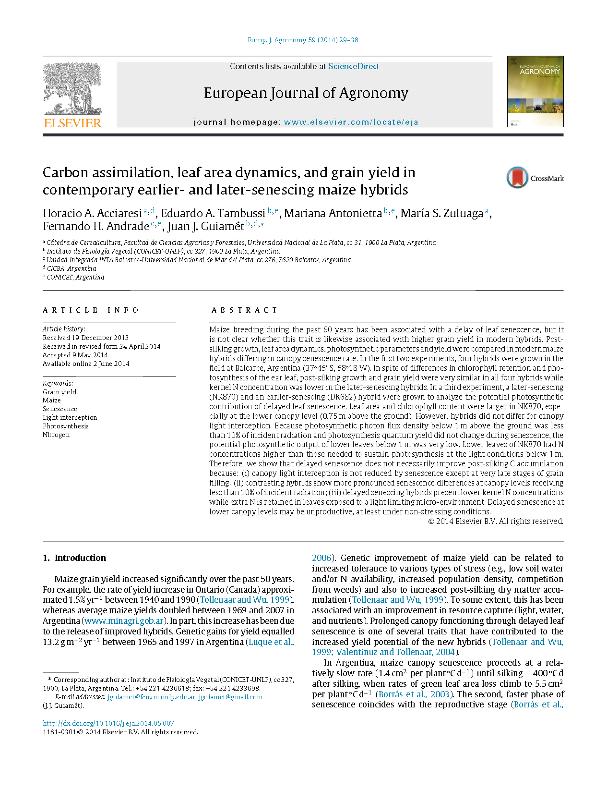Artículo
Carbon assimilation, leaf area dynamics, and grain yield in contemporary earlier- and later-senescing maize hybrids
Acciaresi, Horacio Abel; Tambussi, Eduardo Alberto ; Antonietta, Mariana
; Antonietta, Mariana ; Zuluaga, María Soledad; Andrade, Fernando Héctor
; Zuluaga, María Soledad; Andrade, Fernando Héctor ; Guiamet, Juan José
; Guiamet, Juan José
 ; Antonietta, Mariana
; Antonietta, Mariana ; Zuluaga, María Soledad; Andrade, Fernando Héctor
; Zuluaga, María Soledad; Andrade, Fernando Héctor ; Guiamet, Juan José
; Guiamet, Juan José
Fecha de publicación:
05/2014
Editorial:
Elsevier Science
Revista:
European Journal of Agronomy
ISSN:
1161-0301
Idioma:
Inglés
Tipo de recurso:
Artículo publicado
Clasificación temática:
Resumen
Maize breeding during the past 50 years has been associated with a delay of leaf senescence, but it is not clear whether this trait is likewise associated with higher grain yield in modern hybrids. Post-silking growth, leaf area dynamics, photosynthetic parameters and yield were compared in modern maize hybrids differing in canopy senescence rate. In the first two experiments, four hybrids were grown in the field at Balcarce, Argentina (37°45′ S, 58°18 W). In spite of differences in chlorophyll retention and photosynthesis of the ear leaf, post-silking growth and grain yield were very similar in all four hybrids while kernel N concentration was lower in the later-senescing hybrids. In a third experiment, a later-senescing (NK870) and an earlier-senescing (DK682) hybrid were grown to analyze the potential photosynthetic contribution of delayed leaf senescence. Leaf area and chlorophyll content were larger in NK870, especially at the lower canopy level (0.75 m above the ground). However, hybrids did not differ for canopy light interception. Because photosynthetic photon flux density below 1 m above the ground was less than 10% of incident radiation and photosynthesis quantum yield did not change during senescence, the potential photosynthetic output of lower leaves below 1 m was very low. Lower leaves of NK870 had N concentrations higher than those needed to sustain photosynthesis at the light conditions below 1 m. Therefore, we show that delayed senescence does not necessarily improve post-silking C accumulation because: (i) canopy light interception is not reduced by senescence except at very late stages of grain filling; (ii) contrasting hybrids show more pronounced senescence differences at canopy levels receiving less than 10% of incident radiation; (iii) delayed senescing hybrids present lower kernel N concentrations while extra N is retained in leaves exposed to a light limiting micro-environment. Delayed senescence at lower canopy levels may be unproductive, at least under non-stressing conditions.
Palabras clave:
GRAIN YIELD
,
LIGHT INTERCEPTION
,
MAIZE
,
NITROGEN
,
PHOTOSYNTHESIS
,
SENESCENCE
Archivos asociados
Licencia
Identificadores
Colecciones
Articulos(INFIVE)
Articulos de INST.DE FISIOLOGIA VEGETAL
Articulos de INST.DE FISIOLOGIA VEGETAL
Citación
Acciaresi, Horacio Abel; Tambussi, Eduardo Alberto; Antonietta, Mariana; Zuluaga, María Soledad; Andrade, Fernando Héctor; et al.; Carbon assimilation, leaf area dynamics, and grain yield in contemporary earlier- and later-senescing maize hybrids; Elsevier Science; European Journal of Agronomy; 59; 5-2014; 29-38
Compartir
Altmétricas



